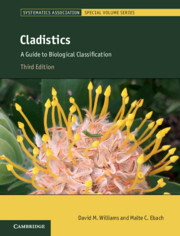Book contents
- Cladistics
- The Systematics Association Special Volume Series
- Cladistics
- Copyright page
- Dedication
- Contents
- Preface
- Acknowledgements
- Introduction: Carving Nature at Its Joints, or Why Birds Are Not Dinosaurs and Men Are Not Apes
- Part I The Interrelationships of Organisms
- Part II Systematics: Exposing Myths
- Part III The Cladistic Programme
- Part IV How to Study Classification
- 8 Modern Artificial Methods and Raw Data
- 9 How to Study Classification: Consensus Techniques and General Classifications
- 10 How to Study Classification: ‘Total Evidence’ vs. ‘Consensus’, Character Congruence vs. Taxonomic Congruence, Simultaneous Analysis vs. Partitioned Data
- 11 How to Study Classification
- 12 How to Study Classification
- Part V Beyond Classification
- Afterword
- Index
- Systematics Association Special Volumes
- References
10 - How to Study Classification: ‘Total Evidence’ vs. ‘Consensus’, Character Congruence vs. Taxonomic Congruence, Simultaneous Analysis vs. Partitioned Data
from Part IV - How to Study Classification
Published online by Cambridge University Press: 20 July 2020
- Cladistics
- The Systematics Association Special Volume Series
- Cladistics
- Copyright page
- Dedication
- Contents
- Preface
- Acknowledgements
- Introduction: Carving Nature at Its Joints, or Why Birds Are Not Dinosaurs and Men Are Not Apes
- Part I The Interrelationships of Organisms
- Part II Systematics: Exposing Myths
- Part III The Cladistic Programme
- Part IV How to Study Classification
- 8 Modern Artificial Methods and Raw Data
- 9 How to Study Classification: Consensus Techniques and General Classifications
- 10 How to Study Classification: ‘Total Evidence’ vs. ‘Consensus’, Character Congruence vs. Taxonomic Congruence, Simultaneous Analysis vs. Partitioned Data
- 11 How to Study Classification
- 12 How to Study Classification
- Part V Beyond Classification
- Afterword
- Index
- Systematics Association Special Volumes
- References
Summary
A significant debate in systematics that began in the late-1970s, developed in the mid-1980s and still with us today is the discussion on the use of what was initially called the ‘Total evidence versus Consensus’ debate. The essence of the debate can be captured with two contrasting approaches to systematics, whether to combine evidence or keep it partitioned.
Information
- Type
- Chapter
- Information
- CladisticsA Guide to Biological Classification, pp. 253 - 272Publisher: Cambridge University PressPrint publication year: 2020
